Why major sneaker brands are running "live raffles" for high heat sneaker drops

Sneaker brands and retailers have been running sneaker raffles for decades. But in recent years, many brands have shifted away from the traditional raffle drop mechanism. Mature brands and retailers now embrace a variety of different drop mechanisms. In this article, we focus on the fastest growing of these—the live raffle. Discover what the live raffle is, how it works, and why it’s taking over the sneaker drop scene.
Online sneaker raffles are a mainstay of the sneaker world. They prevent the massive traffic peaks caused by first-come, first-served (FCFS) sneaker drops, and give retailers extra opportunities to identify and remove illegitimate users and entries.
Retailers and DTC brands use sneaker raffles to create a fairer experience for customers, get greater control over how the sale is run, and lessen the load on their infrastructure.
But in recent years, many brands have moved away from traditional raffles.
They either reserve raffles for only their most hyped drops, or do away with them altogether.
Why?
Because while traditional sneaker raffles solve some issues, they also create new ones. Retailers that run traditional sneaker raffles typically deal with:
- Raffle bots making raffles unfair
- A lack of transparency for customers
- Difficulty capitalizing on hype
- Persistent issues with high demand
- Needing to share customer data with third-party raffle services
Most major brands are shifting to a hybrid drop model. Today retailers and DTC brands typically have a repertoire of different mechanisms they draw upon for different situations.
One key drop mechanism has emerged that lets retailers combine fairness, exclusivity, and hype with a reliable online experience. It's used by SNIPES, Foot Locker, Converse, On Running, and New Balance.
It’s called the live raffle.
Table of Contents
A live raffle is a way to control online traffic and allocate limited resources that’s optimized for fairness and customer experience.
With this process, sneaker retailers still generate the hype of a sneaker raffle and deliver the fairness of randomization, but without needing to worry about handling the massive traffic peaks or sorting through hundreds of thousands of raffle entries.
The live raffle—also known as a pre-queue—works as follows:
1. It gathers customers together
Customers visit the product page and are automatically throttled to a branded waiting room with a timer that counts down to when the sale goes live.
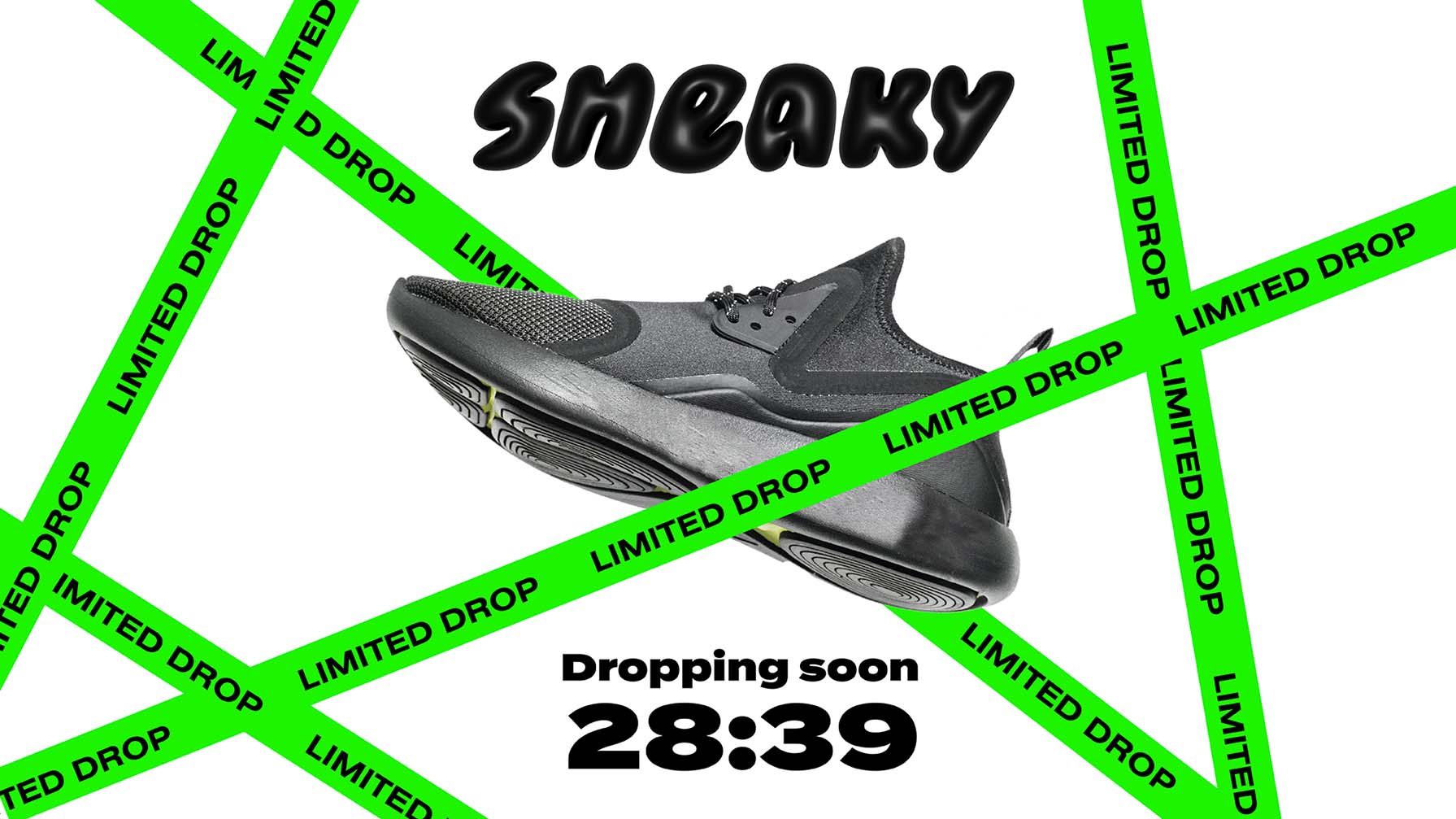
2. It randomizes customers in real-time
When the timer hits zero, everyone on the countdown page is randomized, assigned a spot in line, and throttled into a branded waiting room.
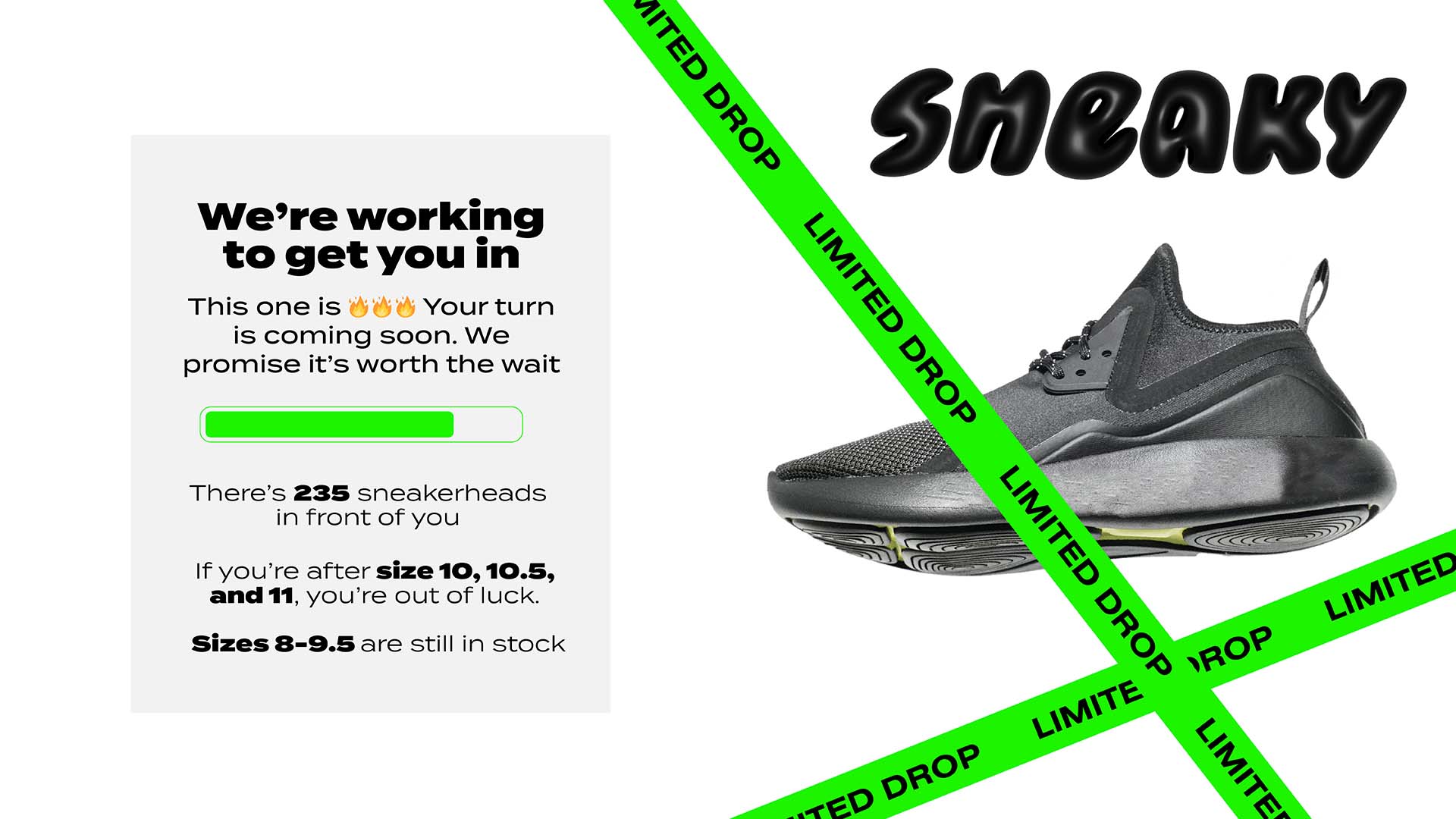
3. It gives customers site access
Customers proceed to the product page according to their queue number, and customers who arrive late are placed at the back of the queue.
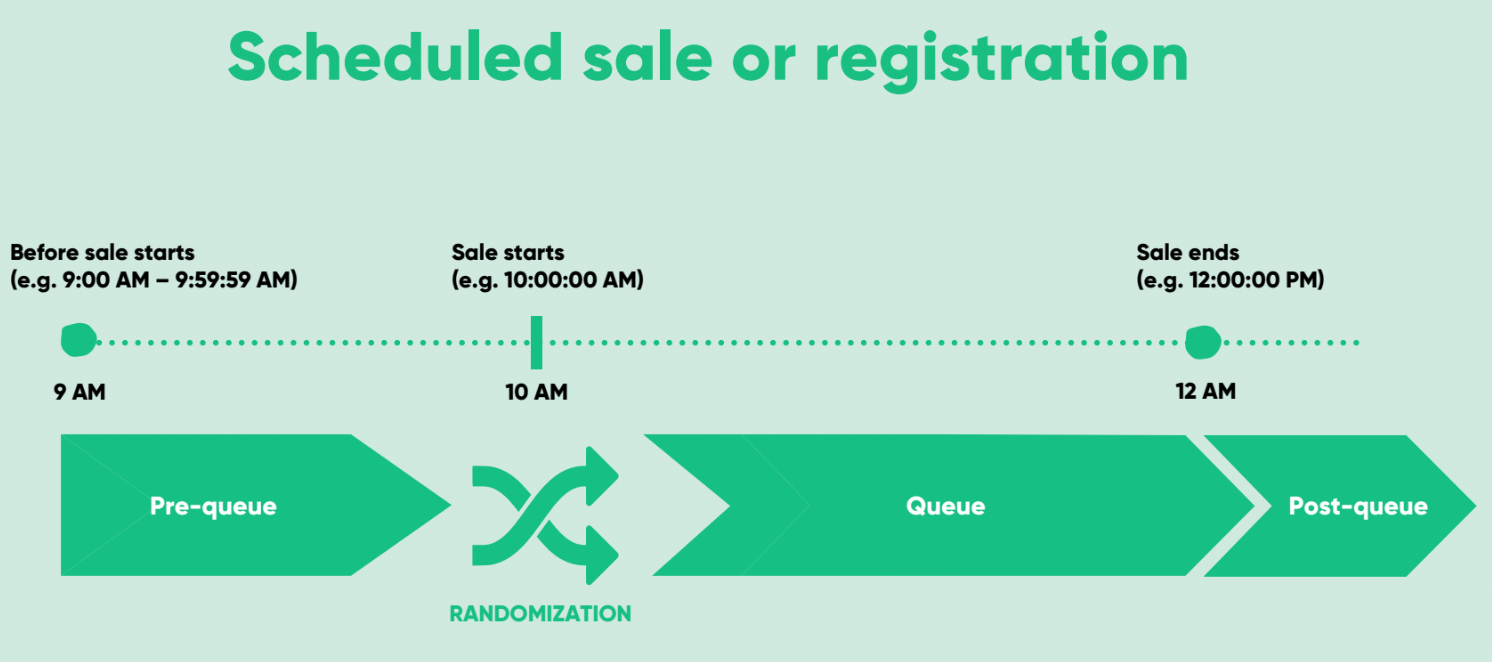
Live raffles using a virtual waiting room address the key issues with traditional raffles. They block bots, ensure transparency, capture hype, protect against high demand, and take none of your valuable customer data.
Let’s look at how.
Like a traditional raffle, the randomization in a live raffle takes away the key advantage bots usually have during first-come, first-served sales—speed.
But unlike a traditional raffle, you can slow down visitors and run checks on them while they’re in the queue.
Just like an airport security checkpoint screens passengers before they board their flights, a virtual waiting room acts as a checkpoint between your web page and the purchase path.
This real-time sanitization lets you block bots before they even get access to the sale. You can use Proof-of-Work challenges, block visitors with data center IP addresses, show CAPTCHAs, limit each visitor to one spot in line based on a unique identifier like user ID or promo code, and more.
What’s more, traditional raffles do nothing about nasty scraper bots that constantly crawl your website for product returns, order cancellations, or discounts they can exploit.
These scrapers not only snatch up inventory but also increase cloud computing costs and spoil marketing analytics. Using 24/7 bot protection, you can block these nasty bots without customers even seeing a waiting room.
RELATED: Queue-it’s Bot Mitigation Toolkit For Your Sneaker Drops

One of the sneaker world’s biggest gripes with sneaker raffles is the lack of transparency. Even though most sneaker raffles are truly random and fair, the sorting process happens behind closed doors, making many customers believe raffles are rigged.
The randomization of a live raffle happens in real-time, meaning customers can see their position in queue and compare it with others.
Live raffles mean it’s not a matter of “either I win, or I lose” for customers. It’s a matter of “either I’m 50th in line or 500th in line.”
This makes a big difference psychologically.
It shows customers exactly how close they were to scoring a pair of hyped sneakers, rather than just telling them they weren’t selected. This makes customers more likely to hold out hope and continue to participate in drops, whether they cop a pair in the live raffle or not.
RELATED: The Psychology of Queuing Revealed in 6 Simple Rules
Sneaker drops succeed based on scarcity and urgency. In the old days, it was the social proof and competition of queues that made people camp out overnight and get into fights over sneakers.
But raffles take the oomph out of sneaker drops. People enter slowly over the course of a week, then those selected to win get an email, and the rest forget about the whole thing. Where’s the fun and excitement in that?
RELATED: 7 Simple Scarcity Marketing Strategies to Supercharge Ecommerce
Unlike traditional week-long raffles, making customers show up for a real-time raffle ensures your drop is your moment.
It isn’t muddied by people delaying their decision or competitors stealing customers’ interest.
And the live raffle mechanism draws on another powerful marketing tool: social proof.
The queuing system built into the virtual waiting room recreates the social proof that made sneaker drops a phenomenon in the first place.
Customers can see how many others are in queue with them, discuss their queue numbers, and share your branded queue page.

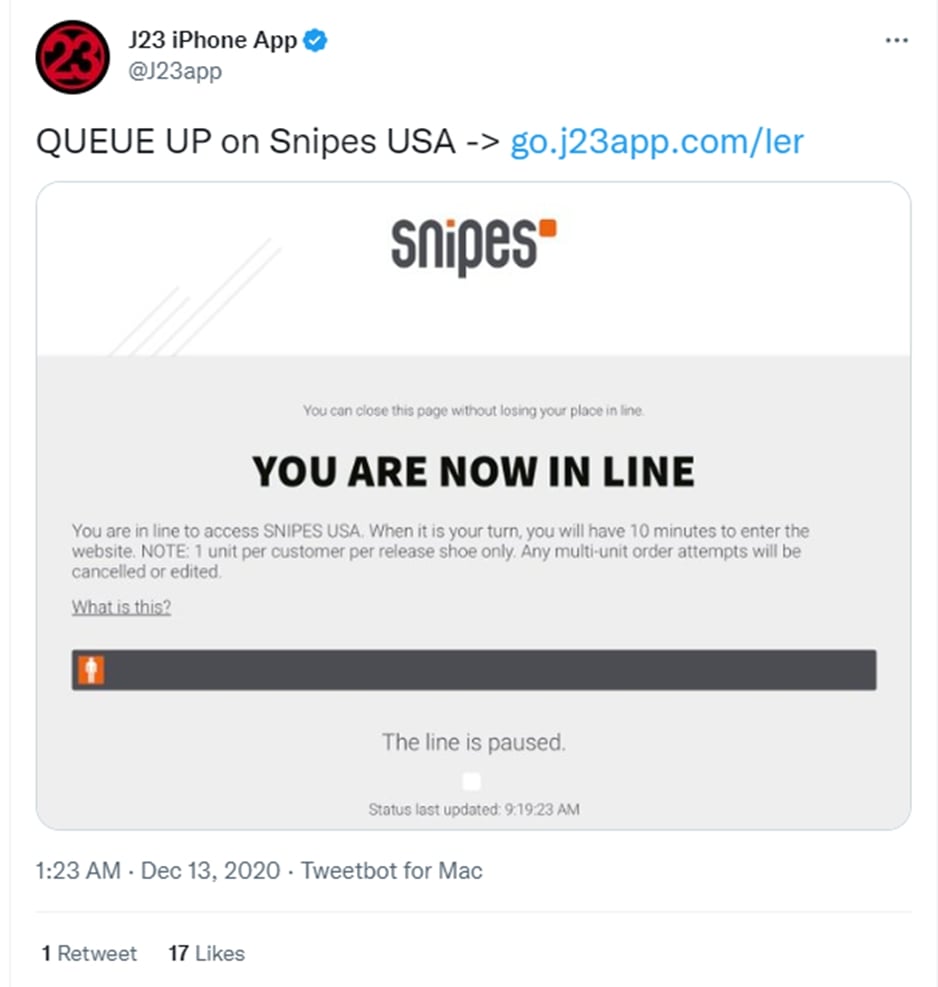
Raffling off positions in queue is actually a digital version of what Supreme did at the height of its hype cycle. They held raffles that gave customers a randomly assigned place in a physical line.
Supreme could still get the hype, community, and social proof queues encourage, without making people camp out overnight and creating issues with too many people showing up and missing out.
Live raffles work in much the same way.
RELATED: What Are Sneaker Raffles, How Do They Work & Why Do Retailers Use Them?
Hype and high demand go together like sneakers and socks.
When Nike wants to generate hype around a release with a “quick draw” (a semi-instant raffle), they bring with that hype huge amounts of traffic. And with huge amounts of traffic comes the same technical issues and website crashes online sneaker raffles were designed to prevent.

This is where applying randomization to site access, rather than raffle entries, can help. With a virtual waiting room, all customers that access the designated product page before or during the drop are automatically throttled off your infrastructure.
The build-up of customers in the waiting room, the countdown timer, and the randomization process, is handled entirely by Queue-it. All you need to do is choose the number of customers you want to access the product page per minute.
Controlling the flow of traffic means you don’t have to worry about bot attacks or how many people show up at once.
The traffic that hits your product page won’t exceed the thresholds you set. This means none of the usual issues retailers face during traffic peaks—no site crashes, slowdowns, errors, overloading bottlenecks and overselling or having payments fail.
RELATED: What is a Virtual Waiting Room?
To give you a peek behind the curtains, the chart below shows how the virtual waiting room worked during a drop for a top 10 global sneaker retailer’s high heat drop.

In the half hour between opening the pre-queue (9:30 a.m.) and starting the sale at 10:00 a.m., almost 100,000 visitors tried to access this retailer’s drop page.
At 10:00 a.m., almost 10,000 visitors flooded the site in just one minute.
But this retailer didn’t have to frantically scale the site or worry about traffic exceeding their predictions.
Their max outflow (the red line) was set to 1,500. So instead of 10 or 100 thousand people accessing the product page at once, just 1,500 customers were directed to the product page to complete their purchase each minute.
RELATED: How High Online Traffic Can Crash Your Website
Because the waiting room page is super lightweight, holding users is less resource-intensive than on an ecommerce site. There’s no updating of inventory databases, or building of cart objects, or bottlenecks with third-party plugins and payment gateways. This means Queue-it can handle more traffic than even the biggest ecommerce sites.
On an average day, Queue-it processes 65 million visitors. It runs on robust and highly scalable cloud-hosted infrastructure that handles some of the world’s biggest online events.
Essentially, it can handle the massive traffic peaks and bot attacks sneaker drops attract, so you and your engineering team don’t have to.
With large volumes of raffle entries and claims of cheating (or “backdooring”, as it’s called in the sneaker world), many brands choose to run their raffles through a third-party provider.
This helps ensure no one within the company cheats and, particularly for smaller sneaker retailers, helps deal with the massive demand, bot mitigation, and randomization required to run a successful raffle.
But using a raffle service poses a different issue: giving your first- and zero-party data to a third-party service provider.
Raffle services get access to your customers’ emails, personal details, payment details, preferences, and other valuable data.
When Queue-it spoke to a major sneaker retailer we work with, they told us that sharing this data is simply something they’d never consider.
They use a virtual waiting room specifically because it’s a bolt-on solution, not a replacement for existing systems. Because it controls and processes web traffic, not customer data.
Implementing the live raffle mechanism requires no changes to business logic, processes, or data collection. Aside from IP addresses, Queue-it doesn’t get access to any private customer information or any of your valuable customer data.
RELATED: Security, Compliance & Accessibility at Queue-it
There’s been a massive push in the sneaker world in recent years to use hyped drops to reward and encourage loyalty.
We’ve seen big brands like Nike and adidas give loyal customers exclusive access to some of the hottest drops of the year, and using a virtual waiting room live raffle mechanism, you can too.
Queue-it’s invite-only waiting room lets you control access to exclusive sales so you can engage loyal customers, block bots, and incentivize loyalty program sign-ups.
The invite-only waiting room is a distinct waiting room that can only be accessed using a unique one-time code, or a link with an approved email address (validated via two-factor authentication).
RELATED: Roll Out the Red Carpet for VIP Customers with Exclusive, Invite-only Drops
Using this feature, you can give a subset of customers first or exclusive access—essentially letting your most valuable customers “skip the line”.
Plus, if you have a large group of customers you want to give exclusive access to—say, all loyalty program members, or newsletter subscribers, or people who missed out on the last drop—you can run an invite-only live raffle. This means you can deliver all the features listed in the 5 points above, but with segmented customer lists.
Use the invite-only waiting room for exclusive or early access to give your 10,000 most loyal members an invite-only live raffle. Then, if there’s still product left, you run a second live raffle an hour later that’s open to all.
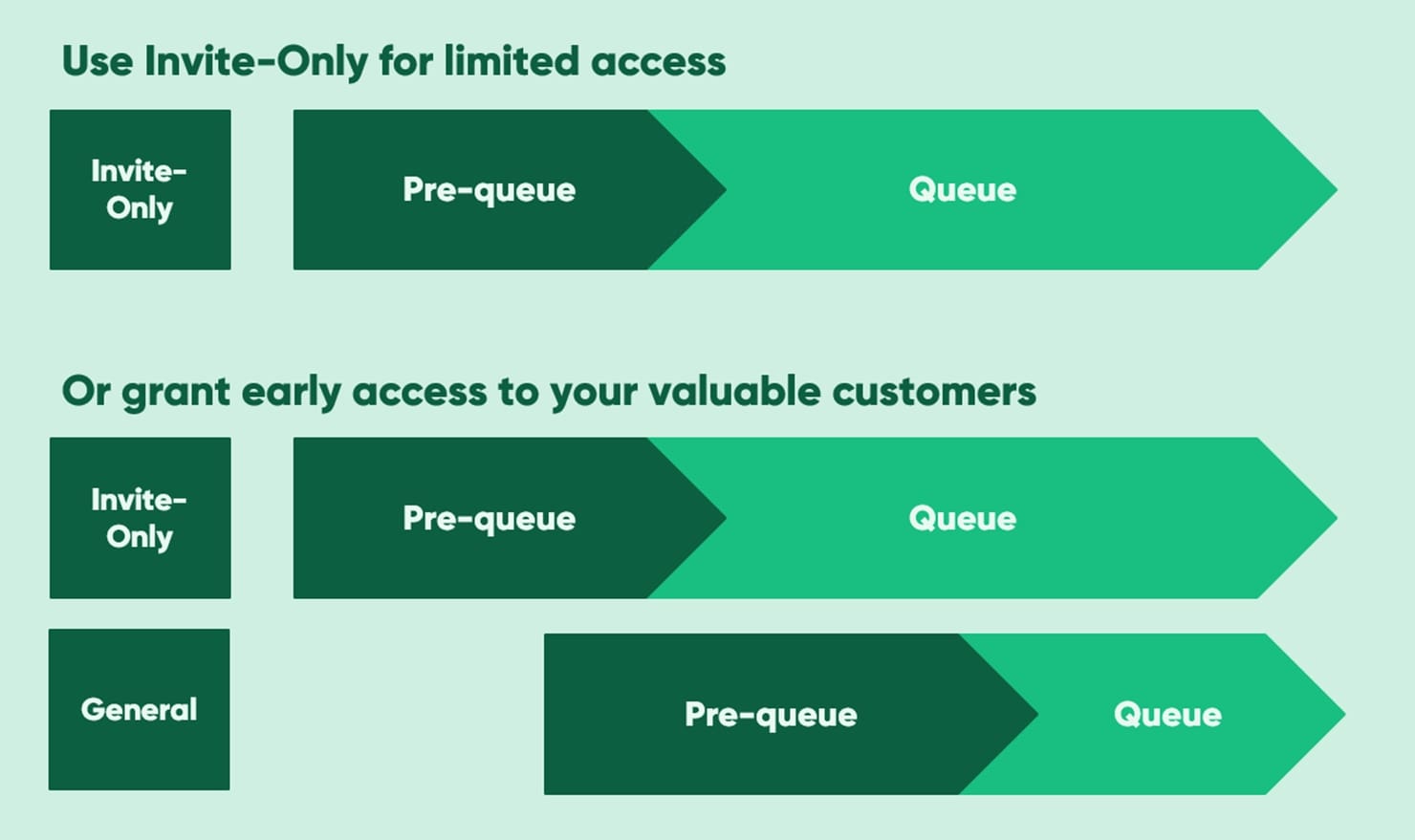
Over the past few decades, the sneaker industry has adopted a business model that parallels the ticketing industry.
Tickets to events are limited in quantity. They’re released (or dropped) at a fixed time then are available till inventory is exhausted. And customers don’t know when tickets will be available again.
Similarly, sneaker brands are embracing increasingly limited-edition shoes in scarce numbers. These sneakers drop at a fixed time and are available until the product sells out. And customers have no idea when the next drop will be.
Both industries create scarcity, competition, urgency, and FOMO for buyers. They make it so if you aren’t there when the ticket or sneaker is released, if you don’t work for it, you probably won’t be able to buy it.
For ticketers and sneaker retailers alike, this set-up generates massive hype and demand and encourages exploitation by bots and resellers.
While the sneaker world initially tackled these issues with raffles, the ticketing world embraced virtual waiting rooms. Today, the world’s biggest ticketing companies use the live raffle technique to tackle high demand and deliver fairness. Ticketmaster, AXS, Stubhub, Ingresso.com, Vue International—they all use virtual waiting rooms and pre-queues with randomization.
And while major sneaker brands are testing out new drop mechanisms and looking for new strategies to manage high demand and bots, virtual waiting rooms are only growing in prominence in ticketing—and they’re exploding in popularity in retail too.
This isn’t to say sneaker raffles will disappear entirely. They’re a part of sneaker culture. But more and more brands are shifting towards a hybrid drop model to avoid running raffles whenever they can.
The live raffle drop strategy is specifically designed to address each of the downsides of traditional sneaker raffles and is emerging as a frontrunner among these new mechanisms. It’s enabling major retailers and brands across industries to:
- Control massive online traffic
- Deliver the fairness of randomization with full transparency
- Block bots before they hit your site
- Utilize social proof & urgency to generate hype
- Deliver exclusivity & reward loyalty at scale
